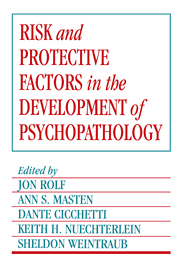Book contents
- Frontmatter
- Contents
- List of contributors
- Preface
- Part I Introduction: Historical and theoretical roots of developmental psychopathology
- Part II Contributions of the high-risk child paradigm: continuities and changes in adaptation during development
- Part III Competence under adversity: individual and family differences in resilience
- 9 Psychosocial resilience and protective mechanisms
- 10 Maternal stress and children's development: prediction of school outcomes and identification of protective factors
- 11 Competence under stress: risk and protective factors
- 12 Stress-resistant families and stress-resistant children
- 13 Children's adjustment to parental divorce: self-image, social relations, and school performance
- Part IV The challenge of adolescence for developmental psychopathology
- Part V Factors in the development of schizophrenia and other severe psychopathology in late adolescence and adulthood
- A closing note: Reflections on the future
- Author index
- Subject index
12 - Stress-resistant families and stress-resistant children
Published online by Cambridge University Press: 06 August 2010
- Frontmatter
- Contents
- List of contributors
- Preface
- Part I Introduction: Historical and theoretical roots of developmental psychopathology
- Part II Contributions of the high-risk child paradigm: continuities and changes in adaptation during development
- Part III Competence under adversity: individual and family differences in resilience
- 9 Psychosocial resilience and protective mechanisms
- 10 Maternal stress and children's development: prediction of school outcomes and identification of protective factors
- 11 Competence under stress: risk and protective factors
- 12 Stress-resistant families and stress-resistant children
- 13 Children's adjustment to parental divorce: self-image, social relations, and school performance
- Part IV The challenge of adolescence for developmental psychopathology
- Part V Factors in the development of schizophrenia and other severe psychopathology in late adolescence and adulthood
- A closing note: Reflections on the future
- Author index
- Subject index
Summary
The purpose of this chapter is to help explain why some children in high-risk circumstances develop more cognitive competence than would be expected considering their backgrounds. One of the factors, we believe, is a certain stress resistance in their families.
The sample of families that we are investigating includes some whose children may become school dropouts, delinquent, drug users, or pregnant within the next 5 years. We have, however, seen some high-risk families whose children appear to have escaped these outcomes. We shall report on the characteristics of these families that seem likely to prevent the poor outcomes that so often befall children in these neighborhoods.
Garmezy (1982) has stimulated great interest in the study of stress-resistant children. In our study we have been impressed by the fact that some high-risk families protect their children from the dangers that surround them. In these cases it seems to us that it is the families, rather than the children, that are stress-resistant. This is not to deny that there are factors in the children that help them resist the influence of a high-risk environment. Even if exposed to such dangers as drugs or alcohol, they are able to cope with them.
Proximal versus distal variables
One purpose of this chapter is to distinguish between stress-resistant children and stress-resistant families. In order to conceptualize this difference we need to recognize that risk variables differ from one another in the degree to which they directly impinge on the child. Social class, for example, is an important risk variable – we shall see later how powerfully social class predicts cognitive outcome. But social class does not impinge directly on the child.
- Type
- Chapter
- Information
- Publisher: Cambridge University PressPrint publication year: 1990
- 140
- Cited by



